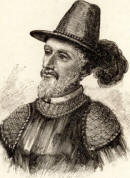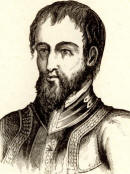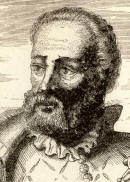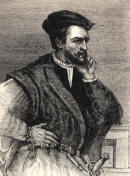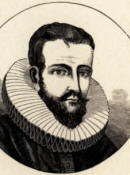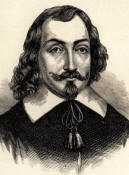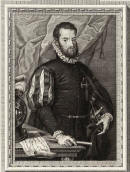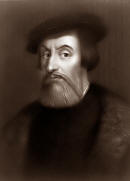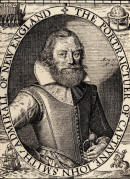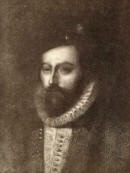|
This Site:
Discovery of America
The Explorers
Post Columbian Exploration
Thirteen Original Colonies
Colonization of America
Colonial Life
Colonial Days and Ways
Independence Movement
The Patriots
Prelude to War
Revolutionary War
Revolutionary War Battles
Overview of Revolutionary War
Revolutionary War
Timeline
Civil War
American Flag
Mexican War
Republic of Texas
Indians
|

Captain John Smith
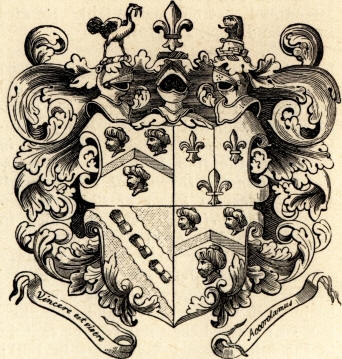 Smith,
JOHN, settler ; born in Willoughby, Lincolnshire,
England, in January, 1579. From early youth he was a soldier, and
for four years he was in wars in the Netherlands. Returning home, he
soon went abroad again to fight the Turks, distinguishing himself in
Hungary and Transylvania, for which service Sigismond Bathori
ennobled him and gave him a pension. Serving under an Austrian
general in besieging a Turkish fortress, he performed a wonderful
exploit. One of the Turkish generals sent a message to the Austrian
camp, saying, " I challenge any captain of the besieging army to
combat." Smith was chosen by lot to accept it. They fought in the
presence of a multitude on the ramparts. Smith cut off his
antagonist's head. A second appeared and suffered the same fate, and
then a third, whose head soon rolled in the dust. The combat ended,
and when Smith was ennobled he had upon his coat of arms, in two
quarterings of his shield, three Turks' heads, with a chevron
between the two upper ones and the lower one. Smith,
JOHN, settler ; born in Willoughby, Lincolnshire,
England, in January, 1579. From early youth he was a soldier, and
for four years he was in wars in the Netherlands. Returning home, he
soon went abroad again to fight the Turks, distinguishing himself in
Hungary and Transylvania, for which service Sigismond Bathori
ennobled him and gave him a pension. Serving under an Austrian
general in besieging a Turkish fortress, he performed a wonderful
exploit. One of the Turkish generals sent a message to the Austrian
camp, saying, " I challenge any captain of the besieging army to
combat." Smith was chosen by lot to accept it. They fought in the
presence of a multitude on the ramparts. Smith cut off his
antagonist's head. A second appeared and suffered the same fate, and
then a third, whose head soon rolled in the dust. The combat ended,
and when Smith was ennobled he had upon his coat of arms, in two
quarterings of his shield, three Turks' heads, with a chevron
between the two upper ones and the lower one.
Taken a prisoner by the Turks, he was sent, a
slave, to Constantinople, where he won the affections of his young
mistress. He was sent by her to her brother in the Crimea, with a
letter avowing her attachment. The indignant Turk cruelly maltreated
Smith, when the latter one day slew his taskmaster, put on the
Ottoman's clothes, mounted a horse, and escaped to a Russian port on
the Don. The account he gave of his personal exploits was most
remarkable.

Captain Smith's Escape from Slavery
On his return to England,
Bartholomew Gosnold
persuaded Smith to engage in founding a
colony in Virginia, and at
the age of twenty-seven years, already greatly renowned, he sailed
for America, Dec. 19, 1606, with
Captain Christopher Newport, who commanded three vessels that
bore 105 emigrants. He was accompanied by
Gosnold, Edward
Maria Wingfield (one of the London Company), George Percy,
Rev. Robert Hunt, and
other men of property. The voyage was by the southern route, and was
long and tedious. Captain Smith's conduct on shipboard was boastful
and arrogant, and quarrels with him were frequent. At the Canaries,
Wingfield charged him with conspiring to usurp the government in
Virginia, and make himself king. There was no head to the company at
sea, for the silly King, with his love for concealment, had placed
the names of the councilors in a sealed box, which was not to be
opened until they should land in Virginia. Some of the passengers,
believing Wingfield's charge to be true, confined Smith and kept him
a prisoner until the voyage was ended. A part of the company landed
on Cape Henry, at the mouth of Chesapeake Bay, had a skirmish with
the Indians, and that night the box was opened, when it was
discovered that Smith was one of the council. But he was rejected.
After resting at Point Comfort, at the mouth of
the James River, they went up that stream, and landed where they
built Jamestown, and chose that for the seat of the new empire.
Captain Smith, with Newport
and twenty men, explored the James River as far as the falls, the
site of Richmond, and made the acquaintance of
Powhatan, emperor of thirty
Indian tribes. They returned and found the government organized by
the choice of Wingfield as president, who, to get rid of Smith,
proposed that he should return to England with Newport and avoid the
disgrace of a trial. The indignant soldier demanded an instant
trial. His innocence was proven, Wingfield withdrew the charges, and
Smith took his seat in the council, when that body demanded that the
president should pay Smith £200 for false imprisonment. All of
Wingfield's property was seized to pay it, when Smith generously
placed it in the public store for the use of the colony.
Sickness prostrated the colony before the close
of summer. At one time there were scarcely ten men who could stand
up. It was discovered that Wingfield was living on the choicest
stores, and was preparing to desert the colony in a pinnace Newport
had left when he returned with the ships to England for more
emigrants and supplies. He was deposed, and one weaker and as wicked
(Ratcliffe) was put in his place. The settlers now took the
management of affairs and put them in Smith's hands, who soon
brought order out of confusion, made the Indians bring stores of
corn, and had the colony well supplied with food for the ensuing
winter. But one-half of the emigrants had perished by the end of
summer. Among the victims was
Gosnold. The
company had instructed the leaders of the colony to explore every
considerable stream in search of the coveted northwest passage.
Smith smiled at the ignorance of the company, but gladly undertook
explorations. He went up the Chickahominy in an open boat to shallow
water among the swamps of the Virginia peninsula. Leaving the boat
in charge of part of his company, he with two others and two Indian
guides penetrated the forest, when Smith was seized by natives under
Opechancanough, king of Pamunkey, an elder brother of
Powhatan, and conducted to the
presence of the emperor at Weroworomoco, on the borders of the York
River.

Captain Smith's Fight with the
Indians
At a great council presided over by
Powhatan, he was doomed to
die. Matoa, or Pocahontas, a
daughter of Powhatan, begged her father to spare the prisoner's
life, but in vain. His head was laid upon two huge stones, and two
stalwart warriors had raised heavy clubs to crush it, when
Pocahontas sprang from her seat by her father's side, clasped the
prisoner's head with her arms, and laid her own head on his (see
POCAHONTAS). The emperor
yielded, and Smith was released and sent to
Jamestown with an
escort, where he found only forty persons, and the stronger ones on
the point of abandoning the settlement and escaping in the pinnace.
He also found that during his absence the little church that had
been built had been burned, and the settlers were worshipping under
a tent. Other emigrants came with Newport in 1608, but they were
chiefly idle and dissolute men, sent thither " to escape ill
destinies at home." Some shining yellow deposits from a stream
issuing from a bank of sand were discovered, and, with the belief
that the stream flowed from a mine of gold, they sought the precious
metal with avidity instead of tilling the ground for food. Smith
implored them in vain to plant and sow; and in the early summer,
disgusted with their fatal folly, he left them, and with his friend
Dr. Russell and a few of the more sensible men he explored the
Potomac and Rappahannock rivers, Chesapeake Bay and its estuaries
and tributaries, and the Patapsco to the site of
Baltimore. He went
up the Susquehanna, probably a few miles above its mouth, where he
heard of the powerful Iroquois Confederacy in the present State of
New York.

Captain Smith Meeting with Powhatan
These explorations were made in two different
voyages in the space of three months. He traveled in his boat about
3,000 miles, made friends of powerful chiefs, and arranged for
future settlements around the Chesapeake. When he returned to
Jamestown early in September, he found the settlers in confusion
again, and three days afterwards he was chosen president of the
council. Soon afterwards Newport came again with supplies and
seventy emigrants, no better than the former ones. Two women came
with them - the wife of one of the emigrants and her maid, Anne
Burrows, who soon afterwards married John Laydon. These were the
first women of European blood seen on the banks of the James. With
these newcomers the London Company sent word that unless the
colonists should send back the ships, commodities enough to pay the
cost of the voyage ($10,000), and other valuable products or
information, they should "be left in Virginia as banished men."
Smith made a spirited reply, begged them to send over emigrants who
would be producers before they could expect much in return. But the
threat assisted Smith in exercising discipline and enforcing g rules
for labor. He demanded six hours of work each day from every
able-bodied man, and said "He who will not work shall not eat." Very
soon the "gentlemen" became expert with the axe and the hoe, yet the
colony continued to depend upon the bounty of the Indians around
them.
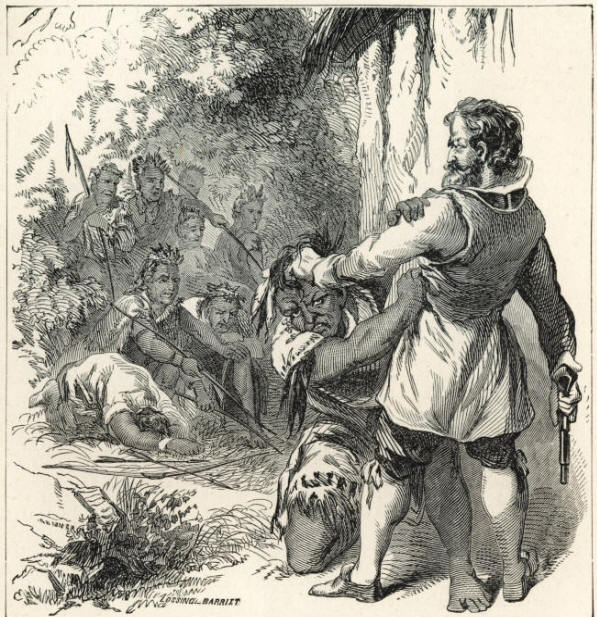
Captain Smith Fighting Powhatan
Meanwhile, Powhatan, though professing
friendship, had conspired against the colonists. Smith, upon
discovering the chiefs treachery, arranged to hold a parley with
him, during which he learned that he was being surrounded by a
crowd of hostile Indians, and that an attempt was to be made upon
his life. Quickly summoning the aid of his soldiers, he seized
Powhatan, and, accusing him of treachery, exacted from him a promise
of submission, under penalty of immediate death. Powhatan,
effectually subdued, agreed to keep peace with the white men, and to
supply them with corn and provisions into the bargain.
Five hundred new settlers came in the summer of
1609, but the appointed rulers under a new charter had been wrecked
in a storm on one of the Bermuda Islands. Anarchy menaced the
colony, but Smith, with his usual energy, " held over " in office,
and by asserting authority became, as he had on other occasions, the
savior of the colony from utter ruin. He devised new expeditions and
new settlements, that the idle and vicious might be employed. In the
autumn of 1609 he was on the James River in a boat, when an
explosion of gunpowder so wounded him that he was compelled to go to
England for surgical treatment, delegating his authority to George
Percy, a, brother of the Duke of Northumberland. He never returned
to Virginia. His labors there
had been disinterested. Brave, honest, and true, he won the
imperishable honor of being the first permanent planter of men of
the Saxon race on the soil of the United States, and is entitled to
the endearing name of Father of Virginia. Smith had made a rude map
of his explorations in south Virginia; he afterwards explored the
coasts of New England (1614), and made a map of the country between
the Penobscot and Cape Cod. He started to found a colony there
(1615) , but failed. The remainder of his life was passed in
retirement. He died in London, England, June 21, 1632. In 1864 a
marble monument was erected to the memory of Captain Smith, on the
Isles 'of Shoals, off the New
England coast. It is placed on a pedestal of rough stone, and is
situated on one of the highest eminences of Star Island. The three
sides of the pillar are occupied by a lengthy eulogium on this hero
of many adventures. Captain Smith published, in 1608, A True
Relation of Virginia; in 1626, The General History of Virginia, New
England, and the Somer Isles; and, in 1630, The True Travels,
Adventurers, and Observations of Captain John Smith in Europe, Asia,
Africa, and America.
|

 Smith,
JOHN, settler ; born in Willoughby, Lincolnshire,
England, in January, 1579. From early youth he was a soldier, and
for four years he was in wars in the Netherlands. Returning home, he
soon went abroad again to fight the Turks, distinguishing himself in
Hungary and Transylvania, for which service Sigismond Bathori
ennobled him and gave him a pension. Serving under an Austrian
general in besieging a Turkish fortress, he performed a wonderful
exploit. One of the Turkish generals sent a message to the Austrian
camp, saying, " I challenge any captain of the besieging army to
combat." Smith was chosen by lot to accept it. They fought in the
presence of a multitude on the ramparts. Smith cut off his
antagonist's head. A second appeared and suffered the same fate, and
then a third, whose head soon rolled in the dust. The combat ended,
and when Smith was ennobled he had upon his coat of arms, in two
quarterings of his shield, three Turks' heads, with a chevron
between the two upper ones and the lower one.
Smith,
JOHN, settler ; born in Willoughby, Lincolnshire,
England, in January, 1579. From early youth he was a soldier, and
for four years he was in wars in the Netherlands. Returning home, he
soon went abroad again to fight the Turks, distinguishing himself in
Hungary and Transylvania, for which service Sigismond Bathori
ennobled him and gave him a pension. Serving under an Austrian
general in besieging a Turkish fortress, he performed a wonderful
exploit. One of the Turkish generals sent a message to the Austrian
camp, saying, " I challenge any captain of the besieging army to
combat." Smith was chosen by lot to accept it. They fought in the
presence of a multitude on the ramparts. Smith cut off his
antagonist's head. A second appeared and suffered the same fate, and
then a third, whose head soon rolled in the dust. The combat ended,
and when Smith was ennobled he had upon his coat of arms, in two
quarterings of his shield, three Turks' heads, with a chevron
between the two upper ones and the lower one.



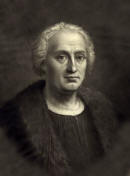
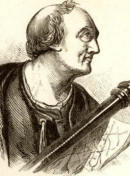
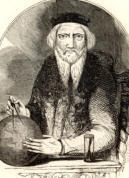
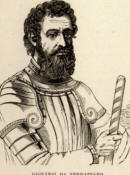
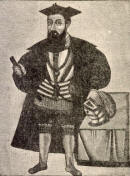
_small.jpg)
